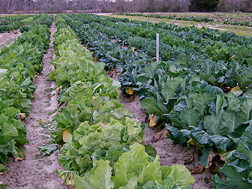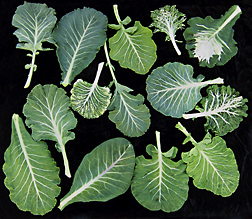A Collection of Carolina Collards
Around New Year’s Day, there’s not much green on the coastal plains of North or South Carolina, except for neat rows of collards (Brassica oleracea). Different varieties of this leafy vegetable are nurtured by gardeners who sow their collard crops from heirloom seeds passed down through generations.
These fields provide garden greens through the late winter—and they are a treasure trove of diverse collard genetic material, or germplasm. To ensure that this valuable resource doesn’t vanish, Mark W. Farnham has begun collecting heirloom collard seeds for preservation in the USDA National Plant Germplasm Collection (NPGC).
Farnham conducts plant genetic research for the Agricultural Research Service (ARS) in Charleston, South Carolina. In 1996, while studying just a few of these old collard varieties—also called “landraces”—he found distinct collard genotypes worthy of collection and preservation.
“Though a lot of these collard varieties are being perpetuated to this day, the different landraces still grown in the region are now in the hands of an aging population,” Farnham says. He realized that the caretakers who cultivated these plants could provide no guarantees for the long-term preservation of the heirloom landraces.
In 2003, the NPGC Plant Exchange Office provided funding for Farnham and his colleagues—entomologist Powell Smith of Clemson University and geographers John T. Morgan and Edward Davis of Emory and Henry College—to search for collard seeds in North and South Carolina.
|
|
A Homegrown Favorite Goes Commercial
Collard—a cole crop related to broccoli, cabbage, and cauliflower—has always been a local staple in the South. But its commercial cultivation expanded dramatically in the 20th century, and is now dominated by a few hybrid varieties.
Collard production in the United States was valued at some $36 million in 2002, when Georgia led national production with almost 6,000 harvested acres. That same year, North and South Carolina harvested more than 2,000 acres each.
Commercial collard crops are not widely grown during hot and humid summer months because they are especially vulnerable to diseases like Fusarium fungus and a variety of insect pests. There have been other downsides as well.
“The genetic erosion of the collard germplasm pool has been severe in recent years because commercial collard hybrids have been adopted by both large-scale producers and home gardeners,” Farnham notes. But plots of heirloom collards can still be found throughout this region.
These collards—often sold at farmers’ markets and roadside stands—are planted in August, and foot-long leaves are harvested from November to the end of February. The plants then flower and produce seeds that are gathered up and stored until the next round of planting.
These crops may provide more than just local color. They could contain genes useful for improving commercial varieties of collard—and varieties of other cole crops as well. In his previous studies, Farnham found indications that these collard landraces carry some genetic resistance to Fusarium.
Searching for Seeds
For several years, Farnham and his associates traveled throughout the Carolina winters on scavenger hunts for seeds. If it was early in the season, they looked for patches of green. In March, they began scouting for bright-yellow collard blossoms, for if the plant was in flower, it signaled that seeds were being kept by the gardener.
When they found a likely field, they stopped and talked to the gardener to find out if the collards were a commercial variety or a landrace with a more limited distribution. If the plant turned out to be an heirloom variety, they asked the owner if they could collect some of its seeds.
“In general, nearly all the seed savers were happy to discuss the collards they were growing,” Farnham says. “Usually, after talking for about an hour or so, they’d be more than willing to let us have some of their seeds.” In this way, the team collected 87 collard seed samples, and sometimes obtained more than one landrace from a single saver.
These visits reinforced Farnham’s fears that unique collard landraces might soon disappear. While the youngest gardener they met was 48, the oldest was almost 90, and most of them were at least 70 years old. There was little evidence that the older gardeners had younger family members or friends who would continue to plant the heirloom varieties in the years to come.
Farnham says, “Many of the places we visited probably won’t have collard gardens in 10 years. I think we successfully saved some unique collard germplasm that was in danger of being lost very soon.” The samples collected by the team are now part of the ARS collection of vegetable Brassicas at Geneva, New York, where scientists maintain facilities for the preservation of plant germplasm.
In his lab, Farnham has grown out plants from some of the collected seeds, which have yielded varieties with distinct leaf shapes, colors, and sizes. He believes these differences indicate that the collected seeds contain a rich and diverse germplasm in need of further definition and study.
More varied and sturdier collard cultivars will be good news for producers and consumers. In the meantime, Farnham is pleased with the results of his fieldwork. “Plant scientists are always excited by new plant varieties and unexpected genetic traits,” he says. “It’s been great to find diversity like this right in our own back yard.”—By Ann Perry, Agricultural Research Service Information Staff.
This research is part of Plant Genetic Resources, Genomics, and Genetic Improvement (#301) and Plant Diseases (#303), two ARS national programs described on the World Wide Web at www.nps.ars.usda.gov.
Mark W. Farnham is with the USDA-ARS U.S. Vegetable Laboratory, 2700 Savannah Hwy., Charleston, SC 29414; phone (843) 402-5327, fax (843) 573-4715.
A Boost for Your Bones
Like other greens that are going gourmet, collards have a culinary following that extends far beyond their regional roots. That appreciation comes with benefits: In addition to vitamin A, USDA nutritionists have determined that collard leaves are loaded with an astonishing amount of bone-bolstering vitamin K.
"A Collection of Carolina Collards" was published in the April 2008 issue of Agricultural Research magazine.








